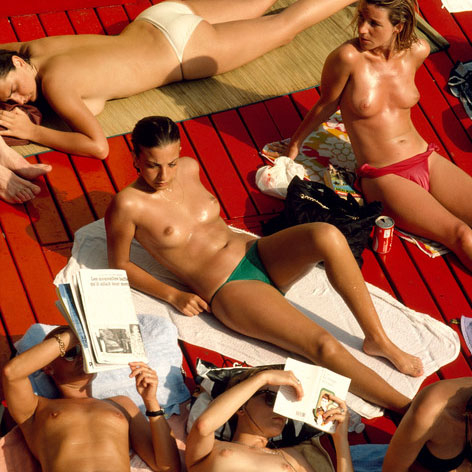“In St. Tropez almost all they wear is the deep dark color of Bain de Soleil,” went the commercial for the tanning gel that greased aspirational hides a glossy orange throughout the 70s and 80s. It was the age of Summer Lovers, when the American Dream was for a vacation spent frolicking in various states of undress on a sophisticated, permissive continent. Today, if you’re headed to Patmos or Capri, Cap Ferret or Cap Ferrat, and hoping to achieve a line-free décolletage on a sun lounger next to an ice bucket full of rosé, sorry. You’ll need to keep on your top. “I used to go to the French Riviera with my parents in the 70s, and every woman would wade into the ocean in a teeny-weeny string and her tits out,” says Claus Lindorff, co-founder of Ron Dorff Paris–Stockholm, a swim- and sportswear company for men and women. Not anymore, he says: “Topless has become démodé in Europe.”
The bare breast used to be a sign of women’s liberation. Now it’s a target, as 10 million phone cameras with 4G links to proliferating social-media sites roam the beach, leaving you no time to hide, much less demand a light airbrushing. A recent study by the French Institute of Public Opinion cited fear of harassment and body shaming for the marked decline in les seins nus on French beaches, but men aren’t the only problem. Twenty-nine percent of French women today disapprove of topless women on the beach, and 7 in 10 are against full nudity. (The immodest still fare better than the very modest: 75 percent of French people are bothered by the sight of a woman in a burkini, and 66 percent want the Islamic bathing costume banned. The days of minding one’s business on the beach are long gone in l’hexagone.)
There are places where beach nudity is a class marker. “In the Swedish archipelago, the snobbiest thing is to see someone coming down in a bathrobe and clogs and nothing else to the beach,” says Lindorff, “because it shows you have a house there, and they cost a fortune. You walk naked to the ocean and naked back to the house. It says, I’m stinking rich and I’ve been here forever.” But outside one’s semi-private confines, or in the Balearics, one of the last almost-anything-goes zones in Europe, free nipples only really happen in corners of the Continent clearly marked “nudista” or “naturiste” or “FKK,” the abbreviation for Freikörperkultur, as it’s called in Germany.
“In the Swedish archipelago, the snobbiest thing is to see someone coming down in a bathrobe and clogs and nothing else to the beach.”
Nudism, like any -ism, has an ideology to it. It’s a different animal from casual toplessness. Today it falls roughly into three camps: wholesome Northern Europeans, gay dune cruisers (see: Sitges near Barcelona, Aldeia do Meco on the Setúbal Peninsula, and Mykonos), and mad swingers, like in Cap d’Agde, near Montpellier, which has its own nude supermarkets and where one touches large surfaces at their peril.

Perhaps hassle-free egalitarianism on the beach is a nice thing in theory, but FKK can be a rules-heavy drag. Wander onto one of the demarcated zones, whether on a North Sea island like Sylt or even at Wannsee, just outside Berlin in Potsdam, and you could be yelled at for leaving anything on at all. “My parents were into FKK when I was very young,” recalls the photographer Jonas Unger, who grew up in a village outside Hamburg and lives in Paris today. FKK started as a social movement in the late 19th century as a sign of physical health and body positivity, but it developed a more political cast in the later 20th century. “Especially in the East,” Unger says, “people would go naked together to show empowerment. Like, the regime couldn’t take that from them. Everyone was the same.” In Croatia, on the Istrian Peninsula, France 24 reports that visitors to the nudist resort Koversada are down by two-thirds from its heyday in the 80s, when the country had as many fully nude campgrounds as France and Germany did. Most of the campers are in their 40s and above, so it’s not about the body beautiful so much as the body unencumbered. Big difference. We’ve come a long way from the St. Tropez tan.


